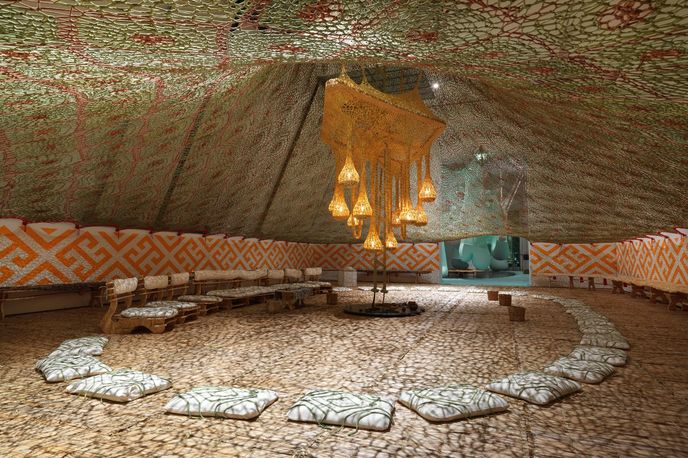ERNESTO NETO AND THE HUNI KUIN ARU KUXIPA: SACRED SECRET
CHRISTY GAST
THYSSEN-BOMEMISZA ART CONTEMPORARY, VIENNA
JUNE 25–OCTOBER 25, 2015
As dusk descended on a cool summer night in Vienna’s baroque Augarten park, an extraordinary seminar commenced on the lawn adjacent to Thyssen-Bornemisza Art Contemporary. The gallery was exhibiting work from a three-location retrospective of Ernesto Neto, the Brazilian artist known for weblike installations of stretched nylon filled with saffron, seeds, and other fragrant matter. As attendees filled benches and blankets on the lawn, a group of presenters filed past Carsten Höller’s resinous blow-up of a psychedelic mushroom and onto a wooden stage. Resplendent in traditional woven robes and iridescent macaw feather headdresses, this delegation of Huni Kuin pajes (aritsts and plant healers) from the Brazilian rain forest were Neto’s collaborators, and they had come to share their knowledge of Amazonian plant medicine with the Western world.
The reader should be forgiven a momentary discomfort with the specter of indigenous people on stage in manicured gardens for “educational purposes,” as it has been practiced since the dawn of the colonial era with disastrous consequences for those on view. Pocahontas was presented before the British monarchy in the sixteenth century and did not live through the return passage; Ota Benga, taken from the Belgian Congo in 1904, was presented in a primate enclosure at the Bronx Zoo. He died by his own hand ten years later.
However, this evening in Vienna, nine Huni Kuin took the stage with an assemblage of presenters from several nations and disciplines, and one by one began matter-of-factly to relate a series of recipes for physiological and spiritual healing using Amazonian plants, including ayahuasca, a DMT-containing brew known for its hallucinogenic effect. They were there as artists, healers, and experts, and this was the audience’s introduction to the new Livro da Cura (Book of Healing), an encyclopedia of plant-based medicine that was published last year in Portugese and the Haxta Kui language and is now being released in English. Organized by a team from the Botanical Garden of Rio de Janeiro, who left field notebooks at secluded settlements along the Jordao River where the Huni Kuin annotated and illustrated each cure as it was performed, the Livro da Cura both shares and protects this spiritual and medical knowledge as the community’s intellectual property.
The Huni Kuin’s decision that now is the time to protect their right to live in and with the forest, by publicly claiming the use and knowledge of specific plants’ chemical compounds as their cultural patrimony, is in line with recent attempts to codify and protect indigenous knowledge as intellectual property. Written and published in a standardized form, these oral traditions become a tangible commodity, a book that stakes claim and gives value to forest-based knowledge in a form that can both limit deforestation and require that credit and compensation be given when those plant compounds are transformed into conventional phar- maceutical treatments.
Sharing the knowledge contained in the Livro da Cura is also the central focus of the installations inside of Thyssen-Bornemisza’s three large galleries. Neto is known for works that envelop the viewer in a way that is indebted to his Brazilian compatriot Lygia Clark, whose Máscaras sensoriais are experienced individually from the inside out, and to Ilya and Emilia Kabakov, whose notion of “total installation” thrusts the viewer into an artwork’s pictorial space. Here Neto moves beyond the Western canon, presenting a major new installation produced in collaboration with the pajés from Rio Jordao.
The exhibition is anchored by CanoeKeneJaguarPataLampLight (2015), a dimly lit ritualistic space in a large central gallery that combines Neto’s biomorphic forms with the architectural impact of a spiritual center. A rooflike structure of crocheted nylon is suspended from the ceiling, arching down gracefully from a central chimney form. Beneath the chimney hangs a bulbous netted chandelier, which meets a marble altar below via a ladder of snakes. The low light filtering through the netted roof brings to mind a gothic cathedral or a dense forest—and, in fact, Neto and his collaborators are making use of the space with a series of events throughout the summer. By inviting social interaction both within the exhibition and around its central ideas, Neto and the Huni Kuin offer the viewer the chance to absorb the raison d’être for the work itself, a cultural and spiritual forest-based literacy that can only be unlocked through a focused accretion of time and knowledge.

